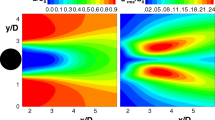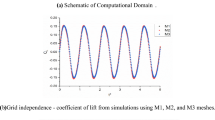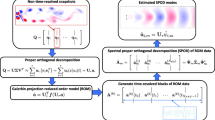Abstract
Visualizations of reduced-order representations of stratified wakes of Reynolds number \(Re \in \{5,25,100\}\times 10^3\) are presented at a fixed internal Froude number. The reduced-order representations are constructed by applying proper orthogonal decomposition (POD) to numerical datasets that are high-resolution, three-dimensional and time-dependent. Due to the transient nature of the flow, the dynamics to be represented are highly non-stationary, posing a challenge for the effectiveness of POD. The translational symmetry inherent in the computational configuration is utilized for the POD analysis. This technique turns out to be effective in terms of improving the convergence of energy content represented by the POD modes and enhancing the interpretability of the temporal dynamics. Individual POD modes representing distinct dynamics of various scales are visualized. In the turbulent region, visualizations of the reconstructed vertical vorticity fields suggest that the dominant length scale of flow structures decreases with the modal index. For internal wave motions, visualizations of the reconstructed vertical velocity fields show the opposite trend, as the wavelength of internal waves observed in the wake’s ambient increases with the modal index. The temporal coefficients for a given mode are observed to vary minimally between \(Re = 2.5\times 10^4\) and \(10^5\), suggesting a potential asymptote of the large-scale temporal dynamics in terms of Reynolds number.
Graphical abstract









Similar content being viewed by others
Notes
In a discrete numerical dataset, the optimal value of \(\lambda \) does not necessarily match an integer multiple of the grid spacing \(\varDelta x\). In order to increase accuracy, \(\lambda \) is computed as an integer multiple of \(0.25\varDelta x\) by interpolating v onto points between the grid points. The reader is referred to Halawa (2020) for details on how the shifts are implemented and how the interpolation is applied.
Four representative modes are chosen here to cover a wider range of modes; in-between modes that are not included show the same general trend.
References
Abdi H, Williams LJ (2010) Principal component analysis. Wiley Interdiscip Rev Comput Stat 2(4):433–459
Abdilghanie AM, Diamessis PJ (2013) The internal gravity wave field emitted by a stably stratified turbulent wake. J Fluid Mech 720:104–139
Berkooz G, Titi ES (1993) Galerkin projections and the proper orthogonal decomposition for equivariant equations. Phys Lett A 174:94–102
Berkooz G, Holmes P, Lumley JL (1993) The proper orthogonal decomposition in the analysis of turbulent flows. Ann Rev Fluid Mech 25:539–575
Billant P, Chomaz JM (2001) Self-similarity of strongly stratified inviscid flows. Phys Fluids 13:1645
Brunton SL, Kutz JN (2019) Data-driven science and engineering: machine learning, dynamical systems, and control. Cambridge University Press, Cambridge
Clyne J, Rast M (2005) A prototype discovery environment for analyzing and visualizing terascale turbulent fluid flow simulations. Electron Imaging 2005:284–294
Clyne J, Mininni P, Norton A, Rast M (2007) Interactive desktop analysis of high resolution simulations: application to turbulent plume dynamics and current sheet formation. New J Phys 9:301
Deusebio E, Caulfield CP, Taylor JR (2015) The intermittency boundary in stratified plane couette flow. J Fluid Mech 781:298–329
Diamessis PJ, Domaradzki JA, Hesthaven JS (2005) A spectral multidomain penalty method model for the simulation of high Reynolds number localized incompressible stratified turbulence. J Comput Phys 202:298–322
Diamessis PJ, Gurka R, Liberzon A (2010) Spatial characterization of vortical structures and internal waves in a stratified turbulent wake using proper orthogonal decomposition. Phys Fluids 22(8):086601
Diamessis PJ, Spedding GR, Domaradzki JA (2011) Similarity scaling and vorticity structure in high-Reynolds-number stably stratified turbulent wakes. J Fluid Mech 671:52–95
Halawa B (2020) Three-dimensional visualization and reduced-order representation of stratied turbulent wakes at varying Reynolds number. Master’s thesis, University of Calgary
Halawa B, Merhi S, Tang C, Zhou Q (2020) Three-dimensional visualization of stratified turbulent wakes at varying Reynolds number. J Vis 23:437–447
He C, Liu Y (2017) Proper orthogonal decomposition of time-resolved LIF visualization: scalar mixing in a round jet. J Vis 20:789–815
Kirby M, Armbruster D (1992) Reconstructing phase space from PDE simulations. Z Angew Math Phys 43(6):999–1022
Kundu PK, Cohen IM, Dowling DR (2012) Fluid mechanics, 5th edn. Academic Press, New York
Lui HF, Wolf WR (2019) Construction of reduced-order models for fluid flows using deep feedforward neural networks. J Fluid Mech 872:963–994
Mansfield D (1996) The use of potential vorticity as an operational forecast tool. Meteorol Appl 3:195–210
Portwood GD, de Bruyn Kops SM, Taylor JR, Salehipour H, Caulfield CP (2016) Robust identification of dynamically distinct regions in stratified turbulence. J Fluid Mech 807:R2
Riley JJ, Lelong MP (2000) Fluid motions in the presence of strong stable stratification. Ann Rev Fluid Mech 32:613–657
Rotunno R, Grubišić V, Smolarkiewicz PK (1999) Vorticity and potential vorticity in mountain wakes. J Atmos Sci 36:2796–2810
Rowe KL, Diamessis PJ, Zhou Q (2020) Internal gravity wave radiation from a stratified turbulent wake. J Fluid Mech 888:A25
Rowley CW, Marsden JE (2000) Reconstruction equations and the Karhunen–Loève expansion for systems with symmetry. Physica D 142:1–19
San O, Maulik R, Ahmed M (2019) An artificial neural network framework for reduced order modeling of transient flows. Commun Nonlinear Sci 77:271–287
Schmid PJ (2010) Dynamic mode decomposition of numerical and experimental data. J Fluid Mech 656:5–28
Shaw J, Stastna M (2019) Feature identification in time-indexed model output. PLoS ONE 14(12):e0225439
Sirovich L (1987) Turbulence and the dynamics of coherent structures. Quant Appl Math 45(3):561–590
Spedding GR (1997) The evolution of initially turbulent bluff-body wakes at high internal Froude number. J Fluid Mech 337:283–301
Spedding GR (2014) Wake signature detection. Ann Rev Fluid Mech 46:273–302
Srinivasan P, Guastoni L, Azizpour H, Schlatter P, Vinuesa R (2019) Predictions of turbulent shear flows using deep neural networks. Phys Rev Fluids 4(5):054603
Taira K, Brunton SL, Dawson ST, Rowley CW, Colonius T, McKeon BJ, Schmidt OT, Gordeyev S, Theofilis V, Ukeiley LS (2017) Modal analysis of fluid flows: an overview. AAIA J 55:4013–4041
Wang Y, Qian J, Song H, Pant K, Yang HQ, Li X, Grismer MJ, Camberos JA, Fahroo F (2014) Feature extraction from massive, dynamic computational data based on proper orthogonal decomposition and feature mining. J Vis 17:363–372
Zhou Q (2015) Far-field evolution of turbulence-emitted internal waves and Reynolds number effects on a localized stratified turbulent flow. Ph.d. thesis, Cornell University, Ithaca, New York
Zhou Q, Diamessis PJ (2016) Surface manifestation of internal waves emitted by submerged localized stratified turbulence. J Fluid Mech 798:505–539
Zhou Q, Diamessis PJ (2019) Large-scale characteristics of stratified wake turbulence at varying Reynolds number. Phys Rev Fluids 4:084802
Acknowledgements
Support by the Natural Sciences and Engineering Research Council of Canada (NSERC) through a Discover Grant (RGPIN-2018-04329) awarded to QZ is gratefully acknowledged. This research was enabled in part by support provided by the Advanced Research Computing (ARC) cluster at the University of Calgary and by Compute Canada (www.computecanada.ca). Additional support for CX and QZ was provided by the Marine Environmental Observation, Prediction and Response (MEOPAR) network of Canada through an early career faculty grant.
Author information
Authors and Affiliations
Corresponding author
Additional information
Publisher's Note
Springer Nature remains neutral with regard to jurisdictional claims in published maps and institutional affiliations.
Rights and permissions
About this article
Cite this article
Halawa, B., Xu, C. & Zhou, Q. Reduced-order representation of stratified wakes by proper orthogonal decomposition utilizing translational symmetry. J Vis 24, 485–499 (2021). https://doi.org/10.1007/s12650-020-00726-y
Received:
Revised:
Accepted:
Published:
Issue Date:
DOI: https://doi.org/10.1007/s12650-020-00726-y




